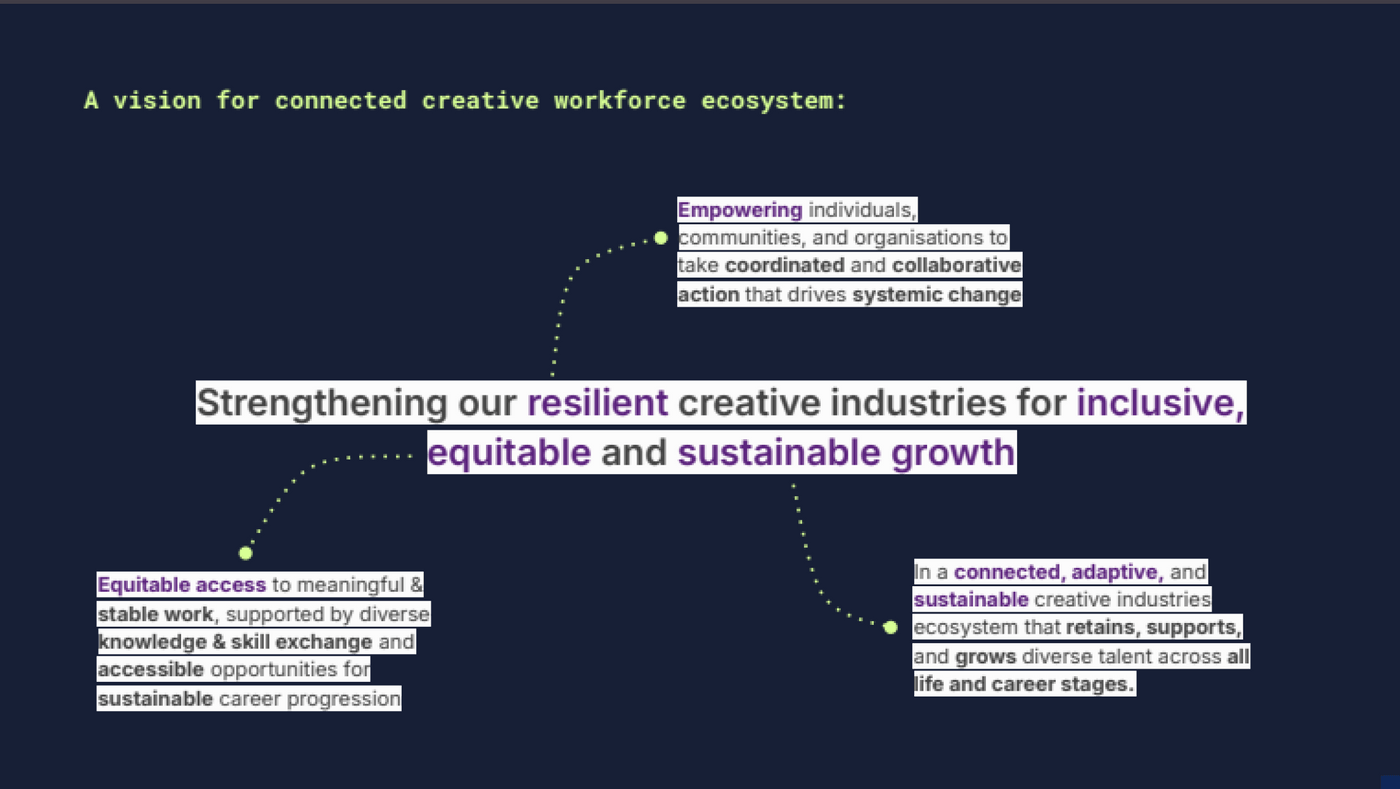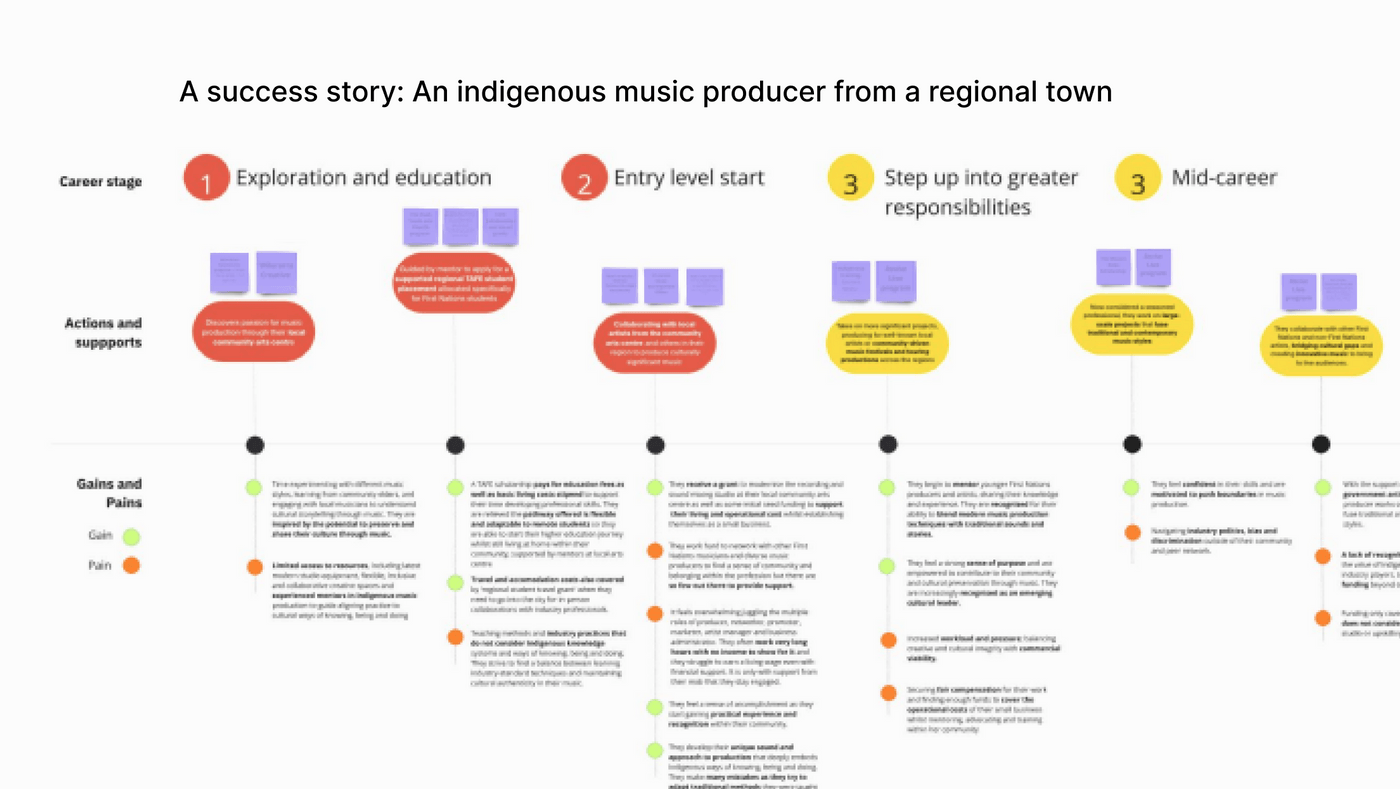The client for this project was Creative Australia, working under the National Cultural Policy, Revive, and in collaboration with Services and Creative Skills Australia (SaCSA). The need for the project emerged from ongoing workforce and skill shortages in the Australian creative industries, exacerbated by funding limitations, precarious work conditions, and slow progress on diversity, equity, and inclusion. It was crucial to conduct this scoping study to identify current workforce skills gaps, the key drivers and root causes of workforce shortages and co-design strategic solutions with industry, artist, worker and education representatives to create a sustainable and inclusive creative workforce for the future.

Creative Australia sought to understand and address several interrelated challenges in the creative industries: widespread skills shortages, underrepresentation of particular groups, and the precarious nature of many creative jobs. The project aimed to identify workforce gaps, understand training needs, improve job quality, and explore barriers to diversity and inclusion. The ultimate goal was to create a set of strategic recommendations that could guide workforce planning and policy development while supporting vocational training and career progression within the sector. The challenge was compounded by the diversity of the sectors involved with distinct mindsets, processes and practices (Games, Screen, Writing & Publishing, Performing Arts, Visual arts and Music) including all the different career stages, roles (creative, production, technical and leadership), and geographic considerations such as remote and regional participation.
Part A of the study: foundational research and data gathering (run by Creative Australia)
Part A of the Arts Scoping Study, completed by Creative Australia before Portable was contracted to complete Part B, was a quantitative exploration of workforce gaps and skills shortages within Australia’s creative industries. It focused on identifying specific roles and skills facing critical shortages across seven creative sectors, including visual arts, performing arts, music, screen production, writing, publishing, and design. This phase relied on a combination of desktop research, employer surveys, and current state mapping initiatives to pinpoint the sectors experiencing the most acute skills shortages.
Key activities in Part A included:
- Desktop research to assess the current workforce challenges and barriers to workforce participation.
- A survey of cross-sector employers aimed at identifying roles experiencing skills shortages.
- Mapping of existing initiatives to understand current efforts aimed at addressing these workforce gaps.
The data gathered in Part A provided a foundational understanding of the structural workforce issues, including the lack of industry-ready graduates, recruitment challenges for technical and management roles, and the struggle to attract and retain senior talent. Part A primarily focused on the employer's perspective, while the role of Part B was to address the lived experiences of individual creatives, particularly freelancers and independent artists.
Part B: building on the findings of Part A with qualitative insights and co-design (delivered by Portable)
Part B of the study was designed to build on the quantitative findings of Part A by adding depth through direct industry engagement. While Part A highlighted critical areas of workforce shortages and employer perspectives, Part B aimed to validate and expand on these findings by diving into the root causes behind the workforce challenges. It involved extensive qualitative research, including direct engagement with over 100 participants from across the creative sectors, such as artists, technical and production workers, educators, and sector employers.
Key aspects of Part B's approach:
- Expanding engagement beyond employers – The Part A survey focused on employer perspectives. In Part B, we actively engaged independent artists, freelancers, and other non-traditional workers to gain a more nuanced holistic understanding of the creative workforce. This shift allowed us to explore the challenges faced by those who don’t fit into formal employment structures, such as precarious work conditions, financial instability, and limited access to career development opportunities.
- Qualitative focus groups and roundtables – Building on the insights from Part A, we conducted 13 focus groups across all seven creative sectors, as well as separate groups for community arts in remote and regional areas. These sessions provided richer insights into the barriers these groups face in accessing stable work, training, and career progression.
- Validation and co-design – Part B also included five roundtable sessions where participants collaboratively validated the strategic directions and impact areas identified in the focus groups. These sessions allowed stakeholders to weigh in on priorities, propose new solutions, and ensure the final recommendations were grounded in real-world needs and challenges. Portable’s process of co-design was essential for developing strategies that could drive real change within the sector.
- Identifying long-term systemic issues – Part B's qualitative approach allowed us to uncover systemic issues, such as the impact of precarious work conditions on mental health, the need for mentorship and leadership development, and the significant career challenges faced by diverse creatives. These insights were crucial for shaping the final strategy and ensuring that it addressed not just immediate skills gaps, but also long-term sustainability for the creative workforce.
- Final strategy development: We synthesised findings into actionable recommendations, pulling together a cohesive strategy with clear outcomes and future directions for the creative workforce.

The insights and impact
From this work, we developed and identified actionable insights for clear direction moving forward, all in service of the greater creative community.
- Current state insights – Overview of the current challenges facing the workforce, including skills shortages, precarious work, and diversity issues.
- Cross-sector and sector-specific findings – Identification of common and unique challenges across creative industries, including recruitment, retention, and career development issues.
- A story of change – A narrative outlining the systemic issues and need for comprehensive, long-term solutions.
- A shared future vision – A vision for a connected and resilient creative workforce ecosystem.
- Guiding principles – Seven key principles for building robust and inclusive workforce conditions.
- Our strategic directions – Four key strategic directions focused on improving access, learning experiences, partnerships, and workplace conditions.
- Desired outcomes – Clear outcomes that aim to create equitable career opportunities and sustainable workforce conditions.
- Impact areas – Identified areas for targeted intervention, including apprenticeships, career pathways, leadership development, and diversity support.
- Actions – Specific actions to be taken by educators, industry leaders, and policymakers to drive change.
- A future state career journey – An example future state journey map showing the moments that matter in a creative career and opportunities for cross sector partnerships, innovation and collaboration to change the narrative, deliver impact and achieve the desired outcomes of providing support at key transition moments improving recruitment, retention and meaningful progression within creative careers.
- Recommendations for the path ahead – Clear recommendations for how to start to action this strategy - our next steps.
The project successfully delivered a comprehensive set of findings and strategic recommendations aimed at creating a sustainable, resilient, and inclusive creative workforce. The final strategy provides Creative Australia and SacSA with actionable solutions to tackle workforce gaps, improve diversity and inclusion, and foster long-term stability in creative careers. The outcomes are aligned with key industry needs and policy goals, supporting a more equitable and dynamic future for Australia's creative sectors.
In turn, Creative Australia recently released the full Creative Workforce Scoping Study, which you can access here. As stated in the release "[t]he study has highlighted opportunities for improved collaboration between governments and agencies; as well as with industry, community organisations, schools, and VET and higher education institutions. It also identifies a range of opportunities to build on, scale up, connect and coordinate existing initiatives, industry-led work, and accredited training opportunities to respond to specific needs of the sector now and into the future."
Testimonials and reflections
"I’m not sure how another consultant would have managed the challenges of our job! Our project involved a tremendous amount of content, multiple stakeholders and views, and a very tight timeline. We were very grateful for Portable’s intelligence and commitment, and for their flexibility when changes were required."
- Christen Cornell, Research Fellow and Manager, Research Partnerships for Creative Australia
"As a former freelance photographer and through my marriage to a lifelong freelance creative, I deeply understand and have felt personally the precarious conditions and financial instability faced by those choosing to work in the creative industries. Meeting such inspiring individuals and leaders, all committed to improving things for the next generation, left me determined to produce actionable recommendations from these conversations and maximise the value of incredible ideas and stories that were shared. There’s already amazing work happening to address these issues in pockets across all the sectors, driven by some extremely passionate and talented individuals and organisations, but the challenge is sharing these successes, embedding and scaling them across the creative workforce ecosystem. This strategy is just the beginning of actioning the system change we imagined and shaped together!”
- Sophie Turner, Portable